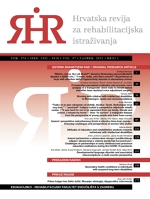Comparative perceptual evaluation and acoustic voice analysis of a transgender client male to female before and after laser-assisted voice adjustment surgery
Comparative perceptual evaluation and acoustic voice analysis of a transgender client male to female before and after laser-assisted voice adjustment surgery
Author(s): Gordana Varošanec-Škarić, Siniša Stevanović, Iva BašićSubject(s): Gender Studies, Applied Linguistics, Phonetics / Phonology, Health and medicine and law
Published by: Sveučilište u Zagrebu, Edukacijsko-rehabilitacijski fakultet
Keywords: transgender; voice quality; VPA protocol; VHI; TVQ MtF; acoustic measures;
Summary/Abstract: In this study, we examined changes in the voice quality of a transgender client who had previously undergone male-to-female (MtF) transition. We conducted a longitudinal phonetic analysis after obtaining recordings from our client before and after undergoing laser-assisted voice adjustment (LAVA) surgery. The following acoustic parameters were compared: fundamental frequency (F0) measures, local jitter, shimmer, harmonic to noise ratio, phonation time, and long-term average spectrum. We assumed that the voice would not change significantly as a result of previous hormonal and vocal therapy, and that its timbre would be closer to female values after LAVA surgery. Since the client was on hormone therapy before the surgery, the average values of F0 corresponded to the values of a normal female voice (190.1 Hz), and, after surgery, the voice became significantly higher in phonation (235.6 Hz). Before surgery, the voice was high for a male voice during reading (mean F0 = 150.19 Hz for non-fricative text (NT) and mean F0 = 158.06 Hz for fricative text (FT)). After surgery, the voice exhibited higher F0 values (F0 = 184.72 Hz for NT and F0 = 191.87 Hz for FT). Before surgery, the voice was average high for a male voice during spontaneous speech (F0 = 119.90 Hz), while after surgery the F0 was 161.33 Hz during spontaneous speech, which is somewhat lower than the average pitch values of the female voice, but its timbral quality is more feminine. Since spontaneous speech is very important for comparison vocal timbre, we can conclude that the 42 Hz difference observed is notable. Although the minimal and maximal values of F0 based on phonation were significantly higher after surgery (p < 0.001), the range was limited. The total results of the F0 measures are higher than expected, while the shortened phonation time points to the need for voice therapy. Considering all our results, we can conclude that it is important to discuss a client’s profession before considering LAVA surgery.
Journal: Hrvatska revija za rehabilitacijska istraživanja
- Issue Year: 57/2021
- Issue No: 1
- Page Range: 40-55
- Page Count: 16
- Language: English

